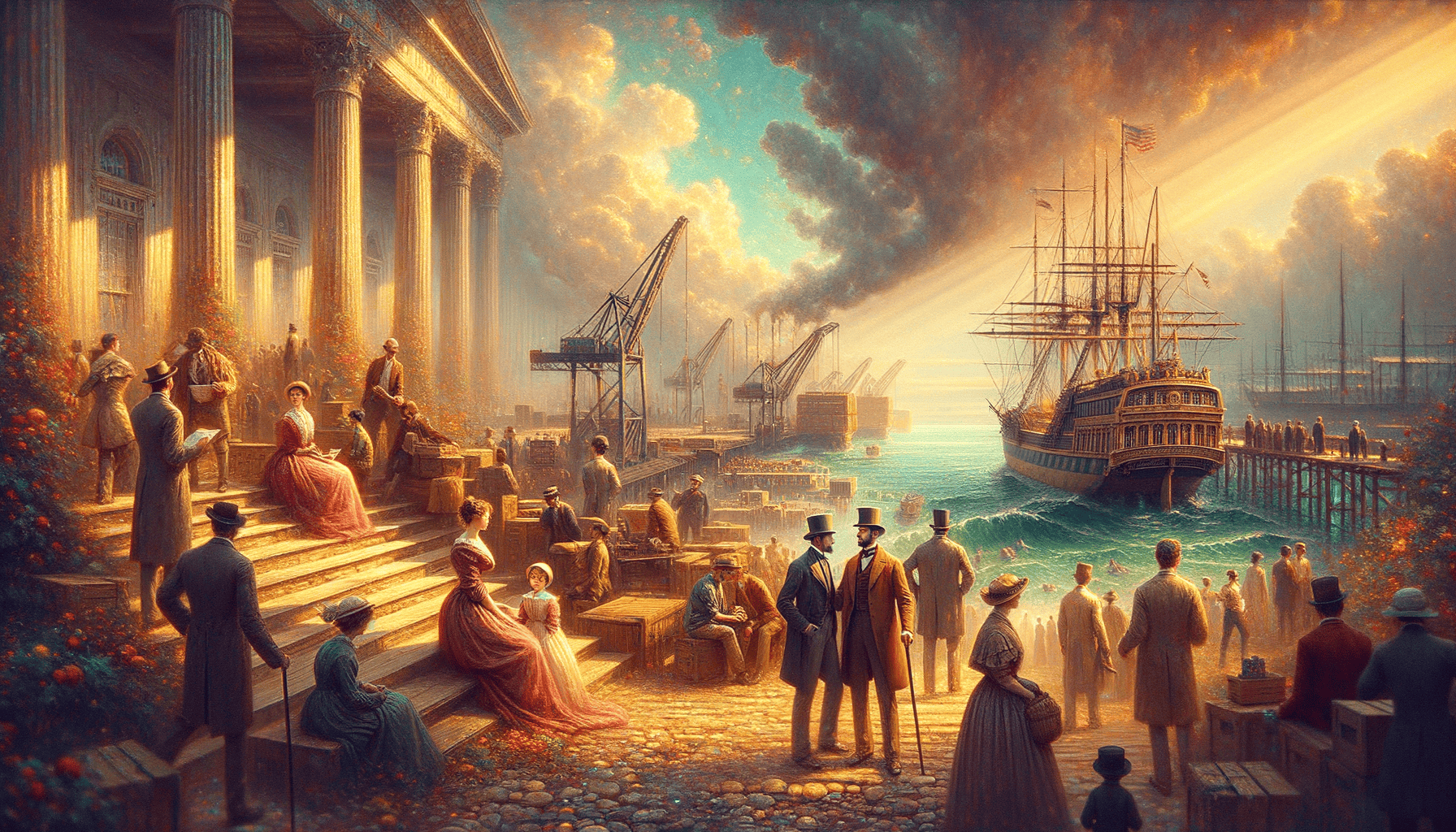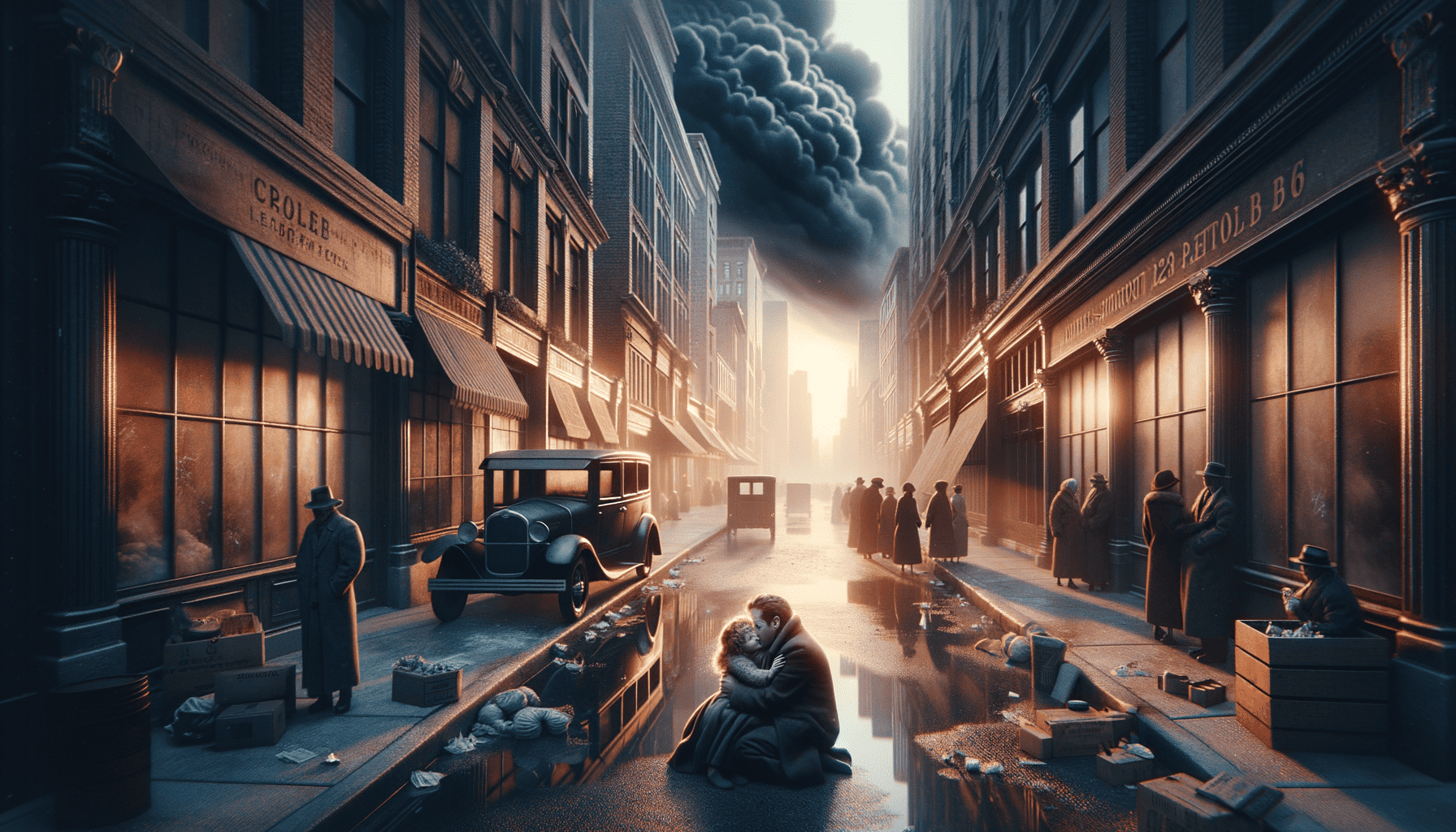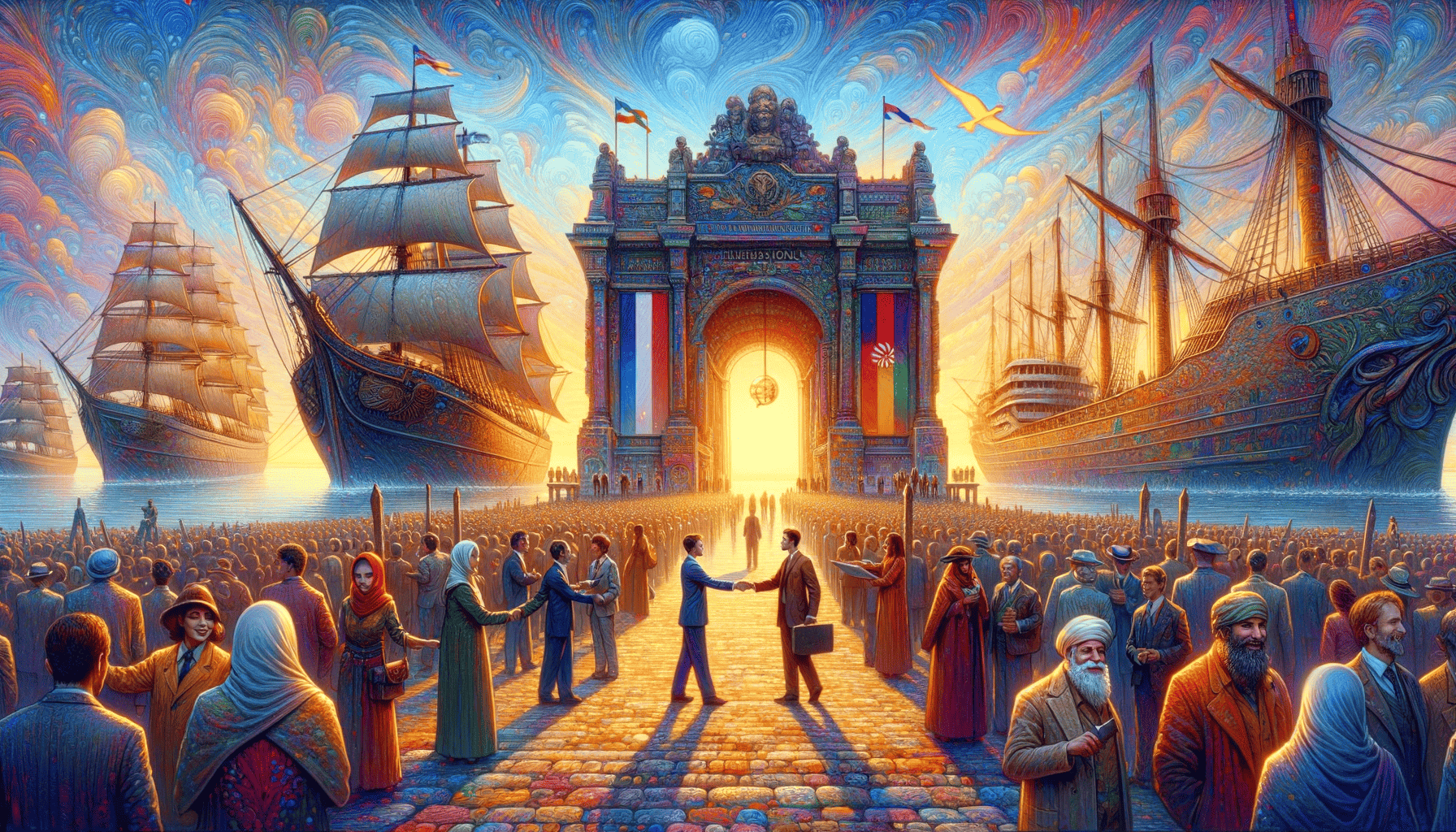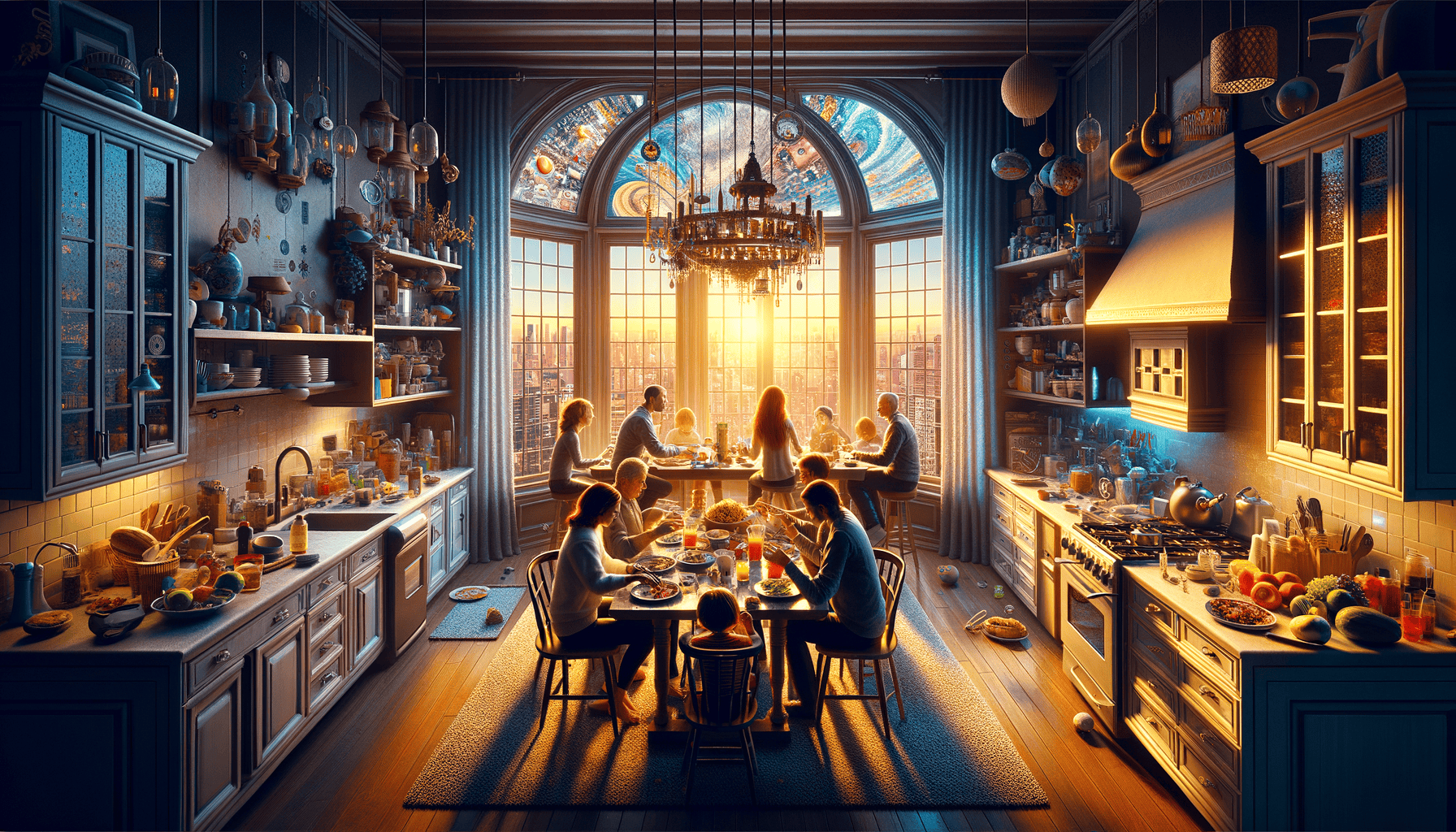The Boston Tea Party – Seeds of Economic Rebellion
Sarah watched from behind a barrel as her father paced nervously in their small Boston shop. The year was 1773, and things were not going well for their family tea business. 🫖
"Papa, why are you so worried?" Sarah asked, her blue eyes wide with concern.
Her father smiled sadly. "The British taxes on tea are making it hard for us to sell anything, sweetheart. We have to charge too much money, and people can't afford it."
A Family’s Struggle
Sarah's family wasn't alone. All over Boston, shop owners were having trouble. The British put special taxes called tariffs on many things Americans wanted to buy. A tariff is extra money people have to pay to buy things from other countries.
“It’s not fair!” Sarah often heard people say in the streets. “Why should we pay extra just because the British King says so?”
The Secret Meetings
One night, Sarah noticed her father sneaking out. He was going to a special meeting at the Green Dragon Tavern. Many people in Boston were planning something big. They were tired of paying unfair taxes.
"We won't let them control our trade anymore!" Sarah heard someone shout through the tavern's open window.
The Big Night
On December 16, 1773, everything changed. Sarah watched from her bedroom window as dozens of men dressed as Native Americans marched toward the harbor. Her father was among them, though he had told her to pretend she didn't know that.
The night was dark and cold. Three big ships sat in the harbor, full of tea from Britain. Sarah could hardly believe what happened next:
• The men climbed aboard the ships
• They opened hundreds of tea boxes
• They dumped all the tea into the ocean!
The next morning, Sarah walked with her father to the harbor. The water was still brown from all the tea, and pieces of wooden boxes floated everywhere.
"Papa, won't we get in trouble?" Sarah whispered.
Her father squeezed her hand. "Sometimes, sweetheart, we have to stand up for what's right, even when it's scary. Those taxes weren't fair to anyone in America."
A New Beginning
The Boston Tea Party showed that people wouldn't accept unfair taxes anymore. It was one of the first big steps toward America becoming free from British rule.
Sarah looked out at the harbor, where seagulls swooped down to investigate the tea-colored water. She didn't know it yet, but she had just watched the beginning of something much bigger than just a protest about tea.
That night, as she helped sweep the shop floor, Sarah heard her father talking to a customer: "Things are going to change now. We're going to build our own country, where trade is fair for everyone."
The stars twinkled over Boston Harbor that night, reflecting off the calm waters where so much tea had been dumped. Something new was brewing in America, and it wasn't tea – it was freedom. 🌟
Hamilton’s Economic Vision – Building America’s Future
Young Thomas Miller stood wide-eyed in his father’s workshop in Philadelphia, 1789. The smell of leather filled the air as his father worked on making shoes. 👞
A New Plan for America
“Papa, why can’t we sell as many shoes as before?” Thomas asked, watching his father struggle with cheaper shoes from England filling the shops.
“The British shoes cost less, son. They’ve been making shoes longer than us and have big factories. It’s hard for American shoemakers to keep up.”
But things were about to change. A smart man named Alexander Hamilton had a plan to help American workers like Thomas’s father. 🏭
Hamilton’s Big Ideas
“We must protect our new industries!” Hamilton told Congress. “If we put small taxes – called tariffs – on goods from other countries, it will help American workers make their own things.”
Hamilton wanted to make sure America could:
• Make its own products instead of buying everything from other countries
• Build factories and create jobs
• Grow strong and independent
A Family’s Hope
One day, Thomas came running into the workshop. “Papa! Papa! They passed Hamilton’s plan! There will be tariffs on shoes from England!”
His father smiled for the first time in months. “This means British shoes won’t be so cheap anymore. More people might buy our American-made shoes.”
Not Everyone Was Happy
Thomas’s friend Sarah lived on a farm outside the city. Her family wasn’t as excited about Hamilton’s plan.
“My pa says the tariffs make it harder to sell our cotton to other countries,” Sarah told Thomas. “They put tariffs on our goods too!”
Growing Stronger Together
As months passed, Thomas noticed changes in the city. New workshops opened. More people had jobs. His father’s shoe business got better.
“You see, Thomas,” his father said one evening, “Hamilton knew that sometimes we need to protect our new businesses so they can grow strong. Just like a young tree needs support to grow tall.” 🌱
Looking to the Future
As Thomas helped in the workshop, learning to make shoes just like his father, he thought about how Hamilton’s ideas were changing America. More factories were being built. More things were being made in America.
“Maybe someday,” Thomas said, “I’ll have my own big shoe factory!”
His father ruffled his hair. “Thanks to Hamilton’s plan, that just might happen, son. That just might happen.” ⭐
The sun set over Philadelphia, casting long shadows through the workshop window. America was growing stronger, one shoe, one factory, one dream at a time.
A Nation Divided – The Hidden Power of Trade Rules
The year was 1858, and young Emma Carter stood on her family’s cotton plantation in South Carolina, watching workers load cotton bales onto wagons. �cotton
Two Different Worlds
“Papa, why is everyone so angry about the new tariffs?” Emma asked her father one hot summer morning.
Mr. Carter wiped his brow. “These tariffs make it hard for us to sell our cotton to other countries, sweet pea. And they make the things we need to buy from the North more expensive.”
A Family Split Apart
Emma’s cousin James lived in Massachusetts. His father owned a textile factory that made cloth. When James came to visit, the adults would argue about trade rules. 🏭
“The South needs to understand – these tariffs protect American workers!” Uncle William would say.
“But they’re hurting our farms!” Emma’s father would answer back.
Hard Times for Everyone
Emma noticed changes happening around her:
• Cotton prices were falling
• Factory goods cost more money
• People were getting angrier
• Families stopped talking to each other
A Child’s View
“Why can’t both sides be happy?” Emma asked her mother one evening.
Her mother sighed. “Sometimes, sweetheart, what helps one person might hurt another. It’s like when you and your brother both want the last cookie – it’s hard to make everyone happy.”
Growing Storm Clouds
As months passed, Emma watched her father grow more worried. The newspapers talked about states wanting to leave America. People whispered about war. ⚡
Letters from the North
Emma kept writing to her cousin James. Their letters showed how different life was becoming:
Emma wrote: “Papa says we might have to sell some land. The tariffs make it hard to make money from our cotton.”
James wrote back: “Father’s factory is doing well. He says the tariffs help keep jobs in America.”
A Country at a Crossroads
One evening, Emma found her father staring at the sunset. “Papa, will things ever get better?”
He pulled her close. “I hope so, Emma. But first, we have to learn that helping one part of the country shouldn’t mean hurting another. We’re all Americans, after all.” 🌟
The warm Southern breeze rustled through the cotton fields as darkness fell. Emma didn’t know it yet, but America was about to face its biggest test ever – learning to work together despite their differences.
Dark Days of Trade – When Walls Got Too High
The crisp October air of 1929 wrapped around young Tommy Miller as he walked home from school in Chicago. Something felt different today – people were running in the streets, and worried faces peered through shop windows. 😟
A World Growing Apart
“Mom, why is Dad so worried?” Tommy asked that evening, watching his father pace the kitchen floor.
“The government just made a new law called the Smoot-Hawley Tariff,” his mother explained. “It’s like putting a big wall around America that makes it hard to trade with other countries.” 🧱
The Domino Effect
Tommy’s father worked at a farm equipment factory that sold tractors to other countries. But when America raised its tariffs, other countries got mad and raised theirs too!
“It’s like a game of catch where nobody wants to throw the ball anymore,” Tommy’s teacher explained to the class. “When countries stop trading, everyone loses.”
Changes at Home
Tommy started noticing differences in his daily life:
• The candy store closed down
• His best friend Billy’s family moved away
• Dad worked fewer days at the factory
• Mom started growing vegetables in their backyard
Letters from Abroad
Tommy had a pen pal in Germany named Hans. Their letters showed how the trade war hurt everyone:
“Dear Hans, Our factory might close because other countries won’t buy our tractors anymore.”
“Dear Tommy, My father’s shoe shop closed because America won’t buy German shoes now.”
Looking for Hope
One day, Tommy found his mom crying over bills. “Will things ever get better?” he asked.
She hugged him tight. “Yes, sweetheart. But first, countries need to learn that helping themselves by hurting others doesn’t work. We all need each other.” ❤️
Signs of Change
“Look!” Tommy pointed to the newspaper headline one morning. “Some people want to lower the tariffs!”
His father smiled for the first time in months. “That’s right, son. People are starting to understand that we need to trade with our neighbors, not shut them out.” 🌅
As Tommy walked to school that day, he noticed new buds on the trees. Maybe, just like spring was coming, better days were ahead for everyone – if they could learn to work together again.
Building Bridges Through Trade – A New World After War
Sarah Jenkins stood at the bustling New York harbor in 1947, watching ships come and go. The war was over, and something exciting was happening. 🚢
A Special Meeting
“Daddy, what’s happening in Geneva?” Sarah asked, pointing to the newspaper headline about countries meeting in Switzerland.
“Something wonderful, sweetheart,” her father smiled. “Countries are creating new rules to help everyone trade fairly. They’re calling it GATT – like a promise between friends to play nice.” 🤝
Sarah’s Family Store
The Jenkins family owned a small toy store in Brooklyn. During the war, they could only sell American toys. But now…
“Look what came today!” Sarah’s father announced, opening a wooden crate. Inside were beautiful dolls from Italy and colorful trains from England.
Making New Friends
Changes were happening everywhere:
• Sarah’s store got toys from many countries
• Her mom could buy fresh fruits even in winter
• Dad’s business grew bigger
• New stores opened on their street
Letters of Hope
Sarah wrote to her cousin Maria in France:
“Dear Maria, Today we got those beautiful French dolls you told me about! Mom says soon we can visit you because countries are becoming friends again.”
Growing Together
“Remember how sad things were during the Depression?” Sarah’s grandmother asked one day. “Now look – when countries work together instead of apart, everyone has more chances to do well.” 🌱
A World of Possibilities
Sarah loved hearing stories from customers about products from different places. Mr. Chen brought tea from China, Mrs. Romano shared Italian chocolates, and Mr. Schmidt showed German cameras.
“It’s like the whole world is becoming one big neighborhood,” Sarah told her father.
“That’s right,” he smiled. “And good neighbors help each other grow.” 🌈
Signs of Success
One day, Sarah helped count the money in the store. “We made more than ever!” she exclaimed.
“Yes,” her father nodded. “When countries trade freely, businesses like ours can grow bigger and better. And that helps everyone!”
Walking home that evening, Sarah noticed how bright and busy their street had become. New stores were opening, people were shopping, and everyone seemed hopeful about tomorrow. The world was healing through trade, one friendly exchange at a time. 🌟
The Modern Trade Dance – Finding Balance in Today’s World
Maya stared at her phone in 2023, looking at pictures of her grandma Sarah’s old toy store. The world of trade had changed so much! 📱
Family Stories
“Grandma Sarah,” Maya asked during their weekly video chat, “was trade easier in your time?”
Sarah laughed softly. “Different, sweetie. Not easier. Every time has its own challenges.” 👵
Maya’s Modern World
Maya’s parents owned an online store that sold products from all over the world. But lately, things were getting tricky:
• Some products cost more because of new tariffs
• Other items were harder to get
• Customers worried about higher prices
• New rules changed often
Understanding Today’s Trade
“It’s like a big puzzle,” Maya’s mom explained. “We need to protect our own workers while also keeping friends with other countries.”
Daily Life Changes
Maya noticed how trade affected her family:
“Mom, why did my favorite sneakers get more expensive?”
“Because some countries are having a trade disagreement,” her mother explained. “But they’re working to fix it.”
Hope for Tomorrow
One evening, Maya had an idea for her school project. She would show how trade connects people around the world!
The Future of Trade
At her school presentation, Maya shared:
“Trade isn’t just about buying and selling. It’s about building bridges between people. When my grandma was young, she saw how countries became friends through trade. Today, we’re learning to keep those friendships strong, even when it’s hard.”
A Global Family
That night, Maya video-chatted with friends from different countries. They shared stories about their families, their hopes, and their dreams. Despite all the grown-up talk about trade wars and tariffs, Maya knew something important:
“We’re all connected now, more than ever before. And together, we’ll find a way forward.” 🌈
As Maya looked out her window at the city lights, she thought about her grandma Sarah’s old toy store. The world had changed so much, but one thing stayed the same: people everywhere still wanted to work together, share their goods, and build a better future for everyone.
The story of trade wasn’t ending – it was just beginning a new chapter. And Maya was ready to help write it. ⭐






